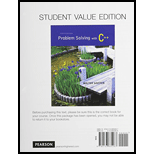
The computer player in
Want to see the full answer?
Check out a sample textbook solution
Chapter 15 Solutions
Problem Solving with C++, Student Value Edition plus MyProgrammingLab with Pearson eText -- Access Card Package (9th Edition)
Additional Engineering Textbook Solutions
Introduction to Java Programming and Data Structures, Comprehensive Version (11th Edition)
Starting Out with Programming Logic and Design (5th Edition) (What's New in Computer Science)
Web Development and Design Foundations with HTML5 (9th Edition) (What's New in Computer Science)
- Write a JAVA program Write a function inside ProblemSolution class whose return type is void, accepts an array and the length of the array as input parameters. The function should call a static method display of MyArray class by passing an array and length value. Input 5 1 5 8 2 0 Where, First line of input represents the size of an array. Second line represents array elements. Output 1 5 8 2 0 Assume that, N is an integer within the range [0 to 10000]. Array elements are integers within the range [-2147483648 to 2147483647].arrow_forwardHere the program to test the class myArray.arrow_forwardIn this task, we’re going to be simulating an email message. ●Create a class definition for an Email.The initialiser takes in two arguments and stores them as instance-level variables:○from_address - the sender’s email address.○subject_line - the subject of the email.○email_contents-the content of the email.●In addition,the initialiser will create two more instance-level variables with defaultvalues:○has_been_read - initialised to False.○is_spam - initialised to False.●Create a function in this class called mark_as_read which should change has_been_read to true.●Create a function in this class called mark_as_spam which should change is_spam to true.●Create another class called "Inbox" to store all emails (note that you can have a list of objects). The initaliser doesn’t take any arguments, and only initialises an empty list. This list is where all of your Email objects will be stored.●Within the Inbox class, create the following methods:○add_email (self, from_address, subject_line,…arrow_forward
- I need help Implement the operators for class Login and class Person. Please help me outarrow_forwardWrite a program namedAveragesthat includes a method that accepts any number ofnumeric parameters, displays them, and displays their average. Demonstrate that theprogram works correctly when passed one, two, or three numbers, or an array ofnumbers.arrow_forward????????: Implement the design of the Pizza class so that the following output is produced: [Your code should work for any number of parameters added in the set_toppings_info method] # Write your codes here. print("Pizza Count:", Pizza.pizza_count) print("=======================") p1 = Pizza("Chicken") p1.set_toppings_info(25, 1, 4, 0) p1.display() print("------------------------------------") p2 = Pizza("Olives") p2.set_toppings_info(15, 1.5, 0, 0) p2.display() print("------------------------------------") p3 = Pizza("Sausage") p3.set_toppings_info(50, 5, 2, 0) p3.display() print("=======================") print("Pizza Count:", Pizza.pizza_count) Output: Pizza Count: 0 ======================= Toppings: Chicken 25 calories 1 g fat 4 g protein 0 g carbs ------------------------------------ Toppings: Olives 15 calories 1.5 g fat 0 g protein 0 g carbs ------------------------------------ Toppings: Sausage 50 calories 5 g fat 2 g protein 0 g carbs ======================= Pizza…arrow_forward
- Write a program to swap the values of private data members of a class named as class_1 and class_2 by using the concept of friend classes.arrow_forwardMake a class of School with Constructor and Destructor also add parameters rooms, staff, address and function initialize () and print () write test program for it. Your code should be divided into 3 files, main.cpp, school.h, school.cpparrow_forwardWe have a parking office class for an object-oriented parking management system using java Add (implement )a function to the Parking Office class to return a collection of customer ids (getCustomerIds) using java I have attached two class diagrams with definitions of all related classes in our system (i.e car, customer, .....). N.B. Parking office methods in the class definition like register, getcustomer and addcharge have already been implemented, we just need an additional getcustomerID function as mentioned above Explain the code you wrote with a few wordsarrow_forward
- Give at least three reasons why it is preferable to use accessors for private types rather than public types.arrow_forwardPlease with interface Write a program in Java for the university consisting of the following categories: A mere Person classification contains the following variables:String name The person's name. 1int id id number. 2Write a constructor that receives the variables and a function (ID int , name String(add) whereYou receive the person's name and ID number and assign them. Write the Students class that inherits from the Person class containing the variablesnext:String Specialization The student's specialization. 1double gpa student average. 2Write a constructor that accepts the variables. (Two and a half degrees). Write the Employee class that inherits from the Person class containing the variablesnext:String jop The job name. 1int salary 2Write a constructor that accepts the variables. Create an interface for the program as shown in the following imagearrow_forwardWrite a program to add members of two different classes using friend Function. Problem: Design: Code: Output:arrow_forward
 C++ Programming: From Problem Analysis to Program...Computer ScienceISBN:9781337102087Author:D. S. MalikPublisher:Cengage Learning
C++ Programming: From Problem Analysis to Program...Computer ScienceISBN:9781337102087Author:D. S. MalikPublisher:Cengage Learning
